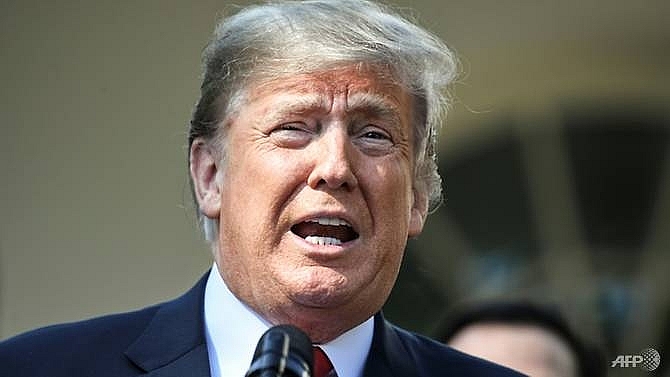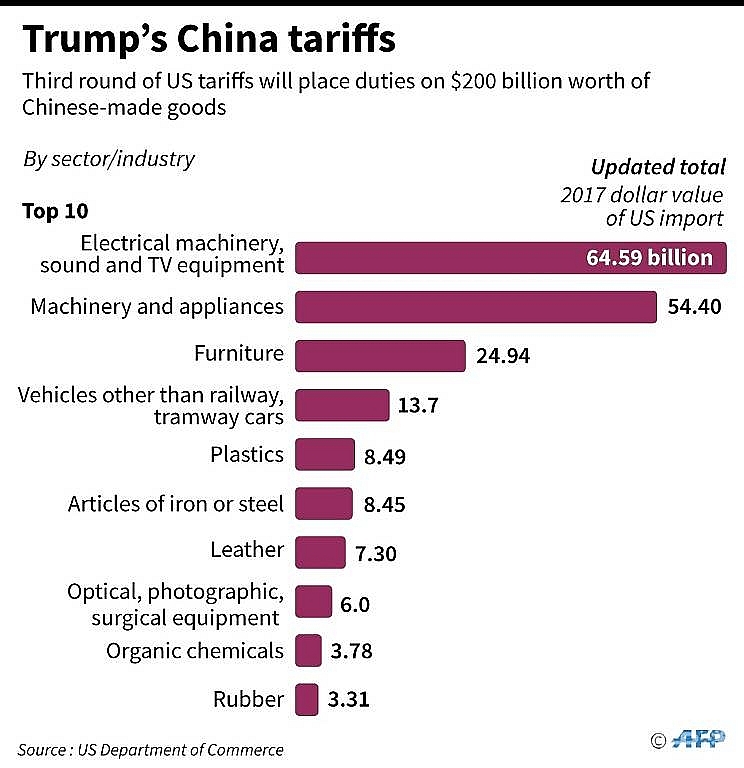Even in new trade deal, US plays hardball with China
 |
| US President Donald Trump told reporters China wanted to open negotiations but "frankly, it's too early to talk". (AFP/Jim WATSON) |
Trump told reporters China wanted to open negotiations but "frankly, it's too early to talk."
With US tariffs now on US$250 billion in Chinese annual exports, about half the total that comes into the US market, and Trump threatening to target the other half, relations with Beijing have deteriorated.
 |
| Chart showing the 2017 value of sectors that will be hit by President Donald Trump's new duties on Chinese-made goods imports. (AFP/Gal ROMA) |
That has spilled over into other areas of diplomacy: A meeting between Defence Secretary Jim Mattis and his Chinese counterpart, General Wei Fenghe, to discuss security issues has been cancelled, a US defence official said on Monday.
And even the new US-Mexico-Canada Agreement that updates the existing continental free trade pact reveals Washington's strategy for countering China - by essentially forbidding any free trade deals with Beijing by any of the USMCA partners.
Trump acknowledged the importance of relations with Beijing, especially in talks with North Korea, and left the door open to negotiations at some point.
"China wants to talk. We want to talk to them. We want them to help us with North Korea," he said, referring efforts to negotiate a deal to denuclearize the Korean peninsula.
But he again slammed China, saying "they have been ripping us off for so many years," and showed no sign of backing down on his threat to impose tariffs on all Chinese imports.
"It's a privilege for them to do business with us."
In the newly-agreed USMCA, negotiating a trade agreement with a "non-market economy" - which describes China's status - is grounds for any of the three North American partners to terminate the agreement and replace it with a bilateral treaty.
'CIRCLING THE WAGONS' AGAINST CHINA
"That's huge. I've never seen anything like that," George Washington University trade expert Susan Aaronson told AFP.
And while many countries have complained about Trump's "saber rattling" on trade, they seem to agree "they should all be aiming their tariffs at China," Syracuse University trade economist Mary Lovely said.
The provision is "a clear signal of where they're headed," she said. "It definitely seems to be circling the wagons against China."
The key lesson Trump could take from the NAFTA negotiations is that strong-arm tactics work and this could have ramifications for coming talks with China, Japan and the European Union.
Trump has threatened to impose steep tariffs on autos worldwide, again invoking a controversial national security justification, and while the USMCA protects Canada and Mexico, the threat has brought Brussels to the table.
Although most trade experts were surprised the final deal turned out as well as it did - incorporating many of the improvements from the Trans-Pacific Partnership that Trump jettisoned by backing out of that agreement on his first day in office - they say Washington's heavy-handed approach worked.
"It's sad to say that," said Patrick Leblond, a trade expert with Canada's Centre for International Governance Innovation.
Trump made unacceptable demands "and then added all these threats," which gained credibility when Trump actually followed through with tariffs on steel and aluminium, Leblond said.
That, Lovely warned, "is going to be the playbook."
Trump spelled it out himself on Monday: "Because of the power of tariffs and the power we have with tariffs, we in many cases won't even have to use them. That's how powerful they are. And how good they are."
What the stars mean:
★ Poor ★ ★ Promising ★★★ Good ★★★★ Very good ★★★★★ Exceptional
Related Contents
Latest News
More News
- 72 nations sign landmark Hanoi cybercrime convention (October 26, 2025 | 18:00)
- UN Secretary-General commends Vietnam’s global leadership (October 26, 2025 | 09:00)
- APEC finance ministers convene to tackle regional challenges (October 22, 2025 | 17:31)
- Rewiring global trade: ASEAN’s rise as supply chain hub (October 17, 2025 | 11:40)
- Vietnam attends first World Nuclear Week Forum in Russia (September 26, 2025 | 10:50)
- Vietnam attends 69th session of IAEA General Conference (September 16, 2025 | 10:00)
- ADB, WB pledge over 12 billion USD for ASEAN power grid, renewable energy projects (August 15, 2025 | 14:18)
- Lowy Institute proposes AI-based tobacco control solutions for ASEAN (August 15, 2025 | 14:14)
- Cloud computing policy to position Malaysia as regional hub by 2030 (August 15, 2025 | 14:11)
- Thailand, Cambodia suffer numerous cyber attacks (August 05, 2025 | 16:19)

 Tag:
Tag:






















 Mobile Version
Mobile Version